|
|

Project Gemini: Bridge to the Moon Missions
|

|
|
Share This Page
|
|
|
|
|
|
|
Follow This Site

|
 |
|
|
|
|

|
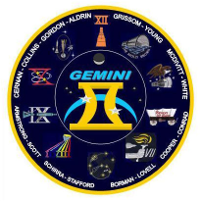 Project Gemini was a program run by the National Aeronautics and Space Administration (NASA) that tested out theories and practices that would be needed to get American astronauts to the Moon.
Project Gemini was a program run by the National Aeronautics and Space Administration (NASA) that tested out theories and practices that would be needed to get American astronauts to the Moon.
Following on from Project Mercury, in which astronauts undertook various tests and maneuvers in one-person capsules, NASA embarked on the two-person-capsule endeavor Gemini, which was originally called Mercury Mark II. Among the goals of the program were to test a person's ability to cope with being in space for long periods of time, to test docking and separating two craft in space, and to enhance re-entry and landing procedures.

The Gemini capsules looked much the same as the Mercury capsules. The Gemini capsules were built to hold two astronauts, however. Launching the Gemini capsules were Titan II rockets, which were originally missiles. NASA enhanced the two-stage rockets so they could launch a payload that was a capsule capable of carrying two people and the equipment they would need.
A total of 20 astronauts were part of the program. Three were alumni of Project Mercury: Gordon Cooper, Gus Grissom, and Wally Schirra. The others were these:
Director of flight crew operations was Project Mercury veteran Deke Slayton. It was he who assigned crews for the various missions, all of which had backup crews assigned as well.
The first two Gemini missions, on April 8, 1964, and Jan. 19, 1965, were unmanned. The first, Gemini 1, tested the Titan-II launch vehicle and the structural integrity of the Gemini capsule, among other things. Technical problems prevented the launch of Gemini 2.
|
Grissom (left) and Young were aboard Gemini 3 on March 23, 1965, for a three-orbit cruise. The only cause for alarm was that the capsule landed 69 miles off course because of a lack of lift during re-entry.
|
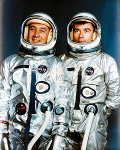
|
|
Taking Gemini 4 up for a spin were Jim McDivitt (right) and Ed White, on June 3, 1965. Their four-day mission featured America's first spacewalk, by White. (Alexei Leonov of the Soviet Union had performed the first-ever spacewalk, a 12-minute departure from Voskhov 2 in March 1965.)
|
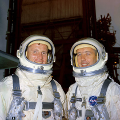
|
|
Gemini 5 featured Conrad (left) and Cooper in space for more than eight days. The pair experienced a handful of technical problems during their mission, but they arrived safely back on Earth and NASA took all of the data and plugged it in to future missions, as things to anticipate and prevent.
|
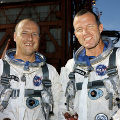
|
|
The next Gemini mission marked a turning point in the program. NASA was ready to try docking two spacecraft together in space. The plan for what would eventually be an Apollo lunar landing mission called for two spacecraft to travel together, then separate in lunar orbit, then reconnect in order to fly home. The Agena docking target intended for Gemini 6 exploded during launch so NASA had to make other plans. The path they chose was to have two Gemini capsules do virtually the same thing. Gemini 7, with Borman (bottom right) and Lovell aboard, embarked on a 14-day mission, starting on Dec. 4, 1965. Gemini 6a, with Schirra (top right) and Stafford aboard, provided a close pass opportunity for Gemini 7 (but only after a second launch attempt, on December 15, a hardware problem preventing the first attempt three days earlier).
|
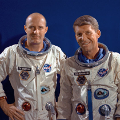
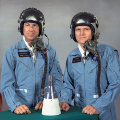
|
|
It was Gemini 8, launching on March 16, 1966, that performed the first docking in space. They had planned some time outside the capsule as well, but a thruster malfunction created a near-death experience for the astronauts, Armstrong (left) and Scott, who finally disengaged their spacecraft from the Agena docking craft and headed for home.
|
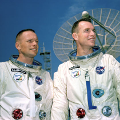
|
|
Launching on June 3, 1966, Gemini 9a, with Cernan (right) and Stafford aboard, had plans for a docking maneuver and a spacewalk, but technical problems prevented both activities from taking place.
|
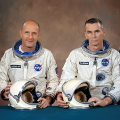
|
|
The next Gemini mission, flown by Collins (right) and Young, was Gemini 10. They succeeded in docking with an Agena target, and Collins did two spacewalks.
|
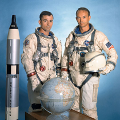
|
|
Conrad (right) and Gordon launched in Gemini 11 on Sept. 12, 1966, and duplicated the feats of Gemini 10, giving them and NASA confidence that procedures had been ironed out. They also conducted an artificial gravity test.
|
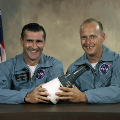
|
|
Aldrin (left) and Lovell were the astronauts on the last Gemini mission, which launched on Nov. 11, 1966. Aldrin performed three spacewalks outside Gemini 12, and the pair successfully docked with their Agena target.
|
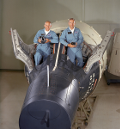
|
In the end, the astronauts and NASA officials declared Project Gemini a success. The next step was the Apollo program, with the destination a manned mission to land on the Moon.
|
|